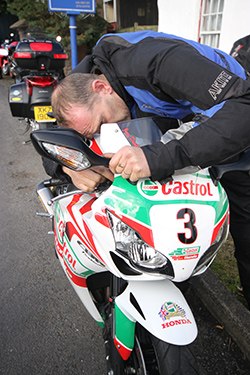 As we wait for any news from the European Commission in relation to the proposal to include motorcycles in mandatory Road Worthiness Testing (RWT) across Europe, here are some news articles from the Vehicle and Operator Services Agency (VOSA) in GB – “Matters Of Testing” blog.
As we wait for any news from the European Commission in relation to the proposal to include motorcycles in mandatory Road Worthiness Testing (RWT) across Europe, here are some news articles from the Vehicle and Operator Services Agency (VOSA) in GB – “Matters Of Testing” blog.
This blog offers official advice and information for the MOT industry from VOSA, an executive agency of the Department for Transport. VOSA officially states that they, “Improve road safety by ensuring drivers, vehicle operators and MOT garages understand and comply with roadworthiness standards. VOSA also provides a range of vehicle licensing, testing and enforcement services.”
One news article highlights some of the horror stories in GB of MoT failures on other vehicles, while these are a few prime examples, millions of vehicles circulate on the roads each day either in as near perfect condition or getting away with horrors like these. Of course motorcyclists would not present their motorcycles for a MoT in such a condition, would they?
The other articles are in reference to motorcycles and LED type combined rear lamp/stop lamp and indicator units, those that are acceptable as being type approved and electric motorcycles and scooters, where testers are not sure what test class they fall into or, what cc to enter in documentation.
Of course if your country does not have MoT type testing for motorcycles (which the European Commission is trying to implement across Europe) then you will not have to worry about correct type approval or checks on modern technology coming through onto motorcycles?
If anybody thinks that our motorcycle MoT in the UK will not change if this EU proposal is defeated, then we would say you would be mistaken, as VOSA are currently conducting a project on MOT modernisation and development to the MOT scheme to help improve the quality of testing.
This includes the implementation of a modernised computer system that will replace existing systems and improving things such as – innovation in equipment and technology – assurance that the right vehicle is tested to the right standard – improving authorisation and training processes – including on line applications.
So we wait for any details from any meetings and any change in a stance from the Council of Ministers that exempts motorcycles from European legislation on mandatory RWT – or the TRAN (Transport & Tourism) Committee whether they have made their minds up on motorcycles – to include or exempt them from the proposals.
Motorcycle Horror Story
One of the arguments put forward for exempting motorcycles (PTW – Powered Two Wheelers) from RWT is that:
“Users of PTW are more aware of the technical condition of their vehicle simply because most technical problems directly impact riding conditions. Besides, the vast majority of riders are well aware of the risks related to riding a PTW and are clearly more safety conscious than most car drivers.”
With the caveat that, “Moreover, technical failures of PTWs require instant action. Reliance on regular annual or bi-annual inspection is misleading. Hence, awareness campaigns, targeting riders having a less passionate relationship with their PTW (along with novice riders in particular), are able to further decrease the small fraction of accidents caused by technical failures.
(FEMA – Position Statement On Periodical Technical Inspections / Road Worthiness Testing)
However let’s be honest, not many motorcyclists maintain or know how to maintain their bikes.
The video below from America, apparently shows the consequences of a badly maintained and worn out chain………..the vast majority of riders may be well aware of the risks and consequences however there are those who maybe do not.
Even if these riders are in the minority, it is our understanding that the proposal on Road Worthiness Testing (RWT) is to catch the lowest common denominator of riders who through no fault of their own do not know or have the confidence to wield a spanner in between services, or recognise a fault and who rely on their motorcycle dealer or shop to maintain their bike in a safe manner.Of course the RWT proposal is a test of roadworthiness at a specific time and interval and would not “catch” defects” in between those intervals, only on the day of the test as does our current MoT in the UK.
However as a RWT for motorcycles is being proposed for those countries who do not have one, it is this “safety” issue on maintaining a road worthy bike that those that oppose it need to take into consideration.
Political Emotions
However what must be remembered is that we are not only dealing with technical experts and legislative experts on the whys and wherefors regarding the introduction (or not) of mandatory RWT in members states that do not have this testing and possible changes to current RWT in all member states that do have it.
What we are dealing with are politicians and as we know, politicians are human and as such have emotions, especially as the drive and thrust behind the proposal is promising better road safety, less collisions and ultimately less injuries and deaths on Europe’s roads.
With the common belief out there that one road death is one too many, it will be hard to “defeat” these emotions all for the sake of a roadworthiness test. Those in favour of RWT would argue – what’s wrong with preventing the death of a person!
These are the debates that are “raging” throughout the motorcycling community in Europe, which is what we are picking up “out there”.
We are aware that there are changes afoot which may well lead to the inclusion of motorcycles as part of mandatory RWT in all member states. Although the discussions in the European Institutions are not over, it will be a close call either way.
As for the UK we already have RWT through our MoT, thank you very much – and from what we can see, it seems to work.
Loose Chain Highside Crash
Matters of testing – Horror Stories
Bulges in tyres and when do they constitute an MOT failure – Well we have seen cracked and broken wheel rims before but not many as bad as this – this customer was unaware of how close they were to a steering failure – lower suspension arm bolt was hanging out – clear example of the failure of a tyres structure causing a bulge – when he unlatched the belt and pulled it out for a closer look this is what was hidden between the seats – decided to extend the cable length with a plastic cable tie to the new calliper.
Original Source – Matters Of Testing – Click Here
Your questions answered: LED combination lamps
Q. I have a motorcycle MOT station here in Dumfries (Dumfries Scooters) I wonder if you could give me a definitive answer on the fitment of LED type combined rear lamp/stop lamp and indicator units that seem to be becoming more popular these days. When lit, the whole lamp illuminates with the stop lamp functioning as normal, and when the indicator is used, 50% of the light turns into flashing amber. There may have been a special notice about these types of lights but I have not seen one. Any help you could give would be greatly appreciated.
A. There are a number of types of LED combination lamps and it is important to recognise which are acceptable and which are not. Where two rear lamps are fitted, one on each side, that double as stop/tail lamps as well as direction indicators -like commonly fitted on some Harley Davidson models – these are type approved and perfectly acceptable.
However, the type that I believe you are referring to, where there is only one centrally mounted lamp that combines stop/tail and both direction indicators are not legal. This is primarily because they do not meet the minimum separation distance between the direction indicators and they should be failed if they are fitted at the time of test. Unfortunately, there is not a specific Reason for Rejection for this, so we require that you use – the illumination of the lamp is affected by the operation of another lamp. This can be applied to both the stop lamp and the rear position lamp.
Original Source – Matters Of Testing – Click Here
How to test an electric bike
With numbers increasing with electric motorcycles and scooters, we’re getting a lot of questions about how to register them on a VTS Device, where testers are not sure what test class they fall into or what cc to enter.
Cubic capacity does not apply to an electrically powered machine, so the correct entry in the cc box is – a simple zero.
First class?
Because the cc is zero, when it comes to selecting the correct test class, some may consider it logical for these machines to be categorised as Class 1. Others regard Class 2 as being correct as this covers all motor bicycles, including Class 1 (with or without side cars) as detailed in the introduction to the Inspection Manual.
So which is correct? Well although it may seem odd, it doesn’t really matter which one you select – there is logic to either argument. In the event that a VTS is only approved for Class 1, the tester will have no option but to select Class 1 or to decline to test because the motorcycle is so large or powerful that they are unfamiliar with such machines.
Tread depth
Regardless of the class selected, test standards for electric motorcycles are no different from those for conventional machines. The only tricky aspect is the 1mm tyre tread depth exemption for machines not being greater than 50cc.
We often get asked if this also applies to electric scooters classed as mopeds (with a maximum power output not more than 4kw and a maximum speed of 45km/h).
Construction and Use regulations only refer to engine capacity in respect of this exemption and make no reference to power output. Therefore these low power electric motorcycles must meet the 1mm tread depth requirement as well as having visible tread across the whole breadth of the tread area.
Original Source – Matters Of Testing – Click Here
Links Information
This guide explains the MOT test and the checks that a motorbike must go through in GB to meet road safety and environmental standards.
The law requires any vehicles driven on the road be kept in a roadworthy condition and that they’re checked annually by a test known as the ‘MOT’.
A motorbike’s first test is required once it’s 3 years old.
Original Source – Matters Of Testing – Click Here
Note: The MoT in Northern Ireland, although similar, the first test required on all cars and motorcycles that are four years old or over. (Source NI Direct – Click Here)


Speak Your Mind